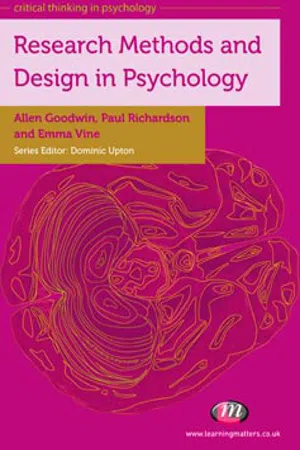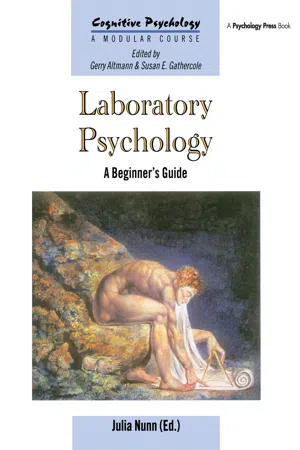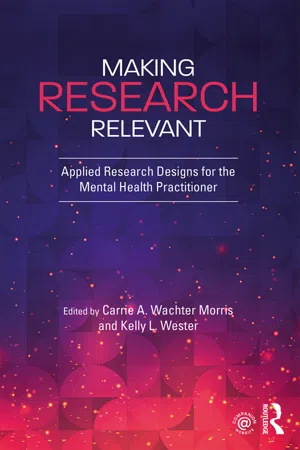Correlational Studies
Correlational studies in psychology involve examining the relationship between two or more variables to determine if they are related and to what extent. These studies do not establish causation but provide valuable insights into the connections between different factors. By analyzing the strength and direction of correlations, researchers can gain a better understanding of the patterns and associations within psychological phenomena.
7 Key excerpts on "Correlational Studies"
- eBook - ePub
- Paul Richardson, Allen Goodwin, Emma Vine(Authors)
- 2011(Publication Date)
- Learning Matters(Publisher)
...What are the implications of this statement? Any conclusions that you may draw from a study involving the association between two variables might be at risk due to the influence of other variables. Therefore, researchers will often measure other variables and partial their effects out, i.e. attempt to remove their influence on the other variables. If you conducted such a study, how would you decide which other variables to collect – what would you need to consider in order to select such variables? An extremely useful extension of researching the degree of association between variables is the ability to predict future scores. This may be a new concept to you in research methodology, but what do you think are the possible benefits of this approach? Can you foresee any limitations? Summary: what you have learned In this chapter, you were introduced to another type of design often used in research – the correlation. However, unlike the experimental designs presented in the preceding chapters, studies that use correlation are not investigating the causal relationship between variables – no variables are being actively manipulated. Instead, this research design helps us to investigate the degree of association between two (or more) variables. People often confuse correlational designs with repeated-measures (within-participant) designs. This is because in both designs participants are tested on the tasks on numerous occasions; however, correlated designs do not require the same tasks to be completed – it is possible to study the association between different tasks or variables! We discussed how the associations between two variables can be visually represented by using a scatterplot. This helps to demonstrate any linear trends in the data. This association can be measured with a correlation coefficient – a figure that lies somewhere between ±1 and 0...
- eBook - ePub
- S Alexander Haslam, Craig McGarty(Authors)
- 2018(Publication Date)
- SAGE Publications Ltd(Publisher)
...9 Examining Relationships between Variables: Correlation Key goals for this chapter Introduce correlation – a procedure for examining relationships between variables. Introduce Pearson’s r – a statistic that quantifies the nature and strength of the linear relationship between two variables. Explain how the results of correlational analysis should be interpreted, with particular reference to the difference between correlation and causation. A lot of what we have talked about in the previous two chapters relates to comparisons between means, and comparing means is what psychologists typically do when they use experimental methodology. However, in a great deal of research investigators confront another interesting question: What is the relationship between two variables? For example, how is stress related to heart disease? How is socio-economic status related to mental health? How is personality related to the judgements people make? This type of question can be addressed by experiments (as in the previous chapter, where we used an example of the relationship between the amount of physical contact and attraction), but is more typically examined in surveys. In surveys the researchers collect information about variables where there may be many different values for each variable (in the attraction study, for example, lots of different levels of contact, not just two, and lots of different levels of attraction). Surveys also often measure two or more variables, each with multiple levels. We can contrast this with the case of a t- test where we have an independent variable with just two levels (a categorical variable) and a dependent variable with multiple levels. In survey research we often want to know whether two variables vary together...
- eBook - ePub
Proposing Empirical Research
A Guide to the Fundamentals
- Mildred L. Patten, Melisa C. Galvan(Authors)
- 2019(Publication Date)
- Routledge(Publisher)
...Topic 14. Correlational Research In a simple correlational study, two quantitative variables are measured and the degree of relationship between them is determined by computing a correlation coefficient. Most educational and psychological tests and scales yield quantitative scores 2 that could be used in correlational research. The following hypotheses lend themselves to correlational research. • It is hypothesized that there is a direct correlation between the U.S. College Board S.A.T. scores and undergraduate first-year G.P.A. • It is hypothesized that depression and scholastic achievement are inversely related. A direct relationship is one in which those participants with high scores on one variable tend to have high scores on the other variable (and those with low scores on one variable tend to have low scores on the other). For direct relationships, correlation coefficients range from 0.00 (no relationship) to 1.00 (perfect, direct relationship). It follows that values near 1.00 (such as.75 and above) are often called “very strong,” and positive values near 0.00 (such as.25 and below) are often called “very weak.” An inverse relationship is one in which those participants who score high on one variable (such as being high in depression) score low on the other (such as being low on scholastic achievement). Values near −1.00 indicate a very strong inverse relationship, while negative values near 0.00 indicate a very weak one. It is important to note that correlation does not imply causality...
- eBook - ePub
Laboratory Psychology
A Beginner's Guide
- Julia Nunn, Julia Nunn(Authors)
- 2018(Publication Date)
- Psychology Press(Publisher)
...For example, psychologists who are interested in the effects of damage to particular areas of the human brain are not ethically able to selectively damage a sample of human brains. However, by keeping records of patients who have brain damage it is possible to study the association between damage to a particular area of the brain and particular behaviours. Similarly, while it might be possible to observe an association between long-term maternal deprivation during infancy and delinquency during adolescence, it would not be ethical to allocate a group of infants to a condition where they were deprived of their mothers. Of course an experimental design permits greater control over the influence of other variables but the advantages of active manipulation of variables carry with them a moral duty to act responsibly. SUMMARY Correlational Studies allow analysis of behaviour that has been passively observed—rather than collected under experimentally rigorously controlled conditions. Determining the cause of a correlation between variables requires special care. If two variables A and B are correlated then there are three possible causal interpretations: (i) A may be the cause of B; (ii) B may be the cause of A; (iii) Some other variable may cause A and B. Correlational Studies can be used to investigate behaviour occurring outside the laboratory which it might not be ethical or practically possible to observe under laboratory conditions. Experimental and correlational approaches: A comparison Whereas the experimenter is interested in the variation he creates by manipulating variables, the correlator is interested in the variation already existing between individuals and/or groups of individuals within or across cultures. The correlator’s aim is to understand the variance produced by nature. For the experimental psychologist individual differences in the subjects of the study are often seen as a problem rather than a focus of interest...
- eBook - ePub
Statistics in Social Work
An Introduction to Practical Applications
- Amy Batchelor(Author)
- 2019(Publication Date)
- Columbia University Press(Publisher)
...5 THE STATISTICS OF RELATIONSHIPS A nalyzing relationships between variables that affect people is as important as analyzing relationships between people. Correlational methods help you better understand people, communities, and policy. If you are interested in what protective factors might help develop resilience in your client, correlations help with that. If you have ever wondered whether a person’s income can help predict school outcomes for their children, correlations help with that too. Or if you have ever wondered whether older adults who are lonely are more likely to experience poor health outcomes, correlations can provide useful context there too. The relationships between these variables affect the people you work with, and correlations help you analyze variables more effectively. LEARNING OBJECTIVES By the end of this chapter, you should understand the following concepts: • What correlation is (and is not) • How to determine the strength and direction of a correlation based on Pearson’s r • How to use the coefficient of determination • How to read scattergrams and correlation tables CORRELATION Correlation is the statistical analysis that describes the strength and direction of a relationship between variables. As discussed in chapter 1, in your practice, you might hope that by increasing the number of counseling sessions a client attends (variable X), you will increase the reported happiness of your client (variable Y). Understanding how one variable is related to another is at the heart of your practice, regardless of the specific context you work in or the population you work with. You must always remember that even strong correlations do not mean one variable caused the variation you see in the other. Correlation is not causation...
- eBook - ePub
Making Research Relevant
Applied Research Designs for the Mental Health Practitioner
- Kelly L. Wester, Carrie A. Wachter Morris, Carrie A. Wachter Morris, Kelly L. Wester(Authors)
- 2018(Publication Date)
- Routledge(Publisher)
...For a positive relationship, as one variable increases, the other variable increases as well. For a negative relationship, as one variable increases, the other variable decreases. The results of a correlational design can only inform researcher about the relationship, but the results do not infer causality of the relationship. In other words, a correlation would not imply that one variable causes another variable but rather would describe the relationship between the two. Figure 7.1 Examples of Correlations Note: (a) no correlation, (b) strong positive correlation, (c) strong negative correlation Data Analysis: Causal-Comparative Research Design Descriptive Statistics Descriptive statistics are used to describe your data. Typically, these statistics include the mean, mode, and median for your groups. For example, when conducting a causal-comparative study, you are testing whether there is a difference in the mean scores of each of your groups. In the case of the present example, you would test whether there is a difference in the mean scores of social support and anxiety between male and female clients. Descriptive statistics do not typically allow you to draw inferences or conclusions based on the mean scores but simply provide you a visual of whether one group is, on average, greater or less than another group. Inferential Statistics Inferential statistics are used in a causal-comparative research to demonstrate a relation between your independent and dependent variables (Brewer & Kubn, 2012). Unlike descriptive statistics, inferential statistics allow you to make inferences, or conclusions, about your results...
- Nancy Fenton, Jessica Flitter(Authors)
- 2015(Publication Date)
- Research & Education Association(Publisher)
...Double blind studies eliminate both experimenter and participant bias. STUDY TIP Be able to identify the participants, variables, and groups within a sample experiment. A researcher investigating the effects of listening to music while studying on test performance randomly assigns high school student participants to a music group or a quiet group while preparing for a test. The researcher subsequently compares the two groups’ test scores using inferential statistics and concludes that p =.05, which indicates the results are statistically significant. • The participants in this study are high school students. • The independent variable in this study is listening to music. • The dependent variable in this study is test performance. • The control group in this study consists of students randomly assigned to the quiet group for studying. • The experimental group in this study consists of students randomly assigned to listen to music while studying. Correlational Method Correlational Studies allow researchers to determine whether a relationship exists between two or more variables. Although correlational research cannot determine cause and effect, these studies illustrate the strength and direction of the relationship between variables, allowing for prediction. The data used in the correlational method is collected through other research designs, such as surveys, interviews, and case studies. Even very strong correlations cannot be perceived as cause and effect relationships because it is possible that both variables are in fact caused by an additional factor in what is referred to as the third-variable problem. Variables may be found to be correlated either positively or negatively. A positive (direct) correlation means that, as one variable increases, so does the second variable or, as one variable decreases, so does the other. In a positive correlation, both variables move in the same direction...






